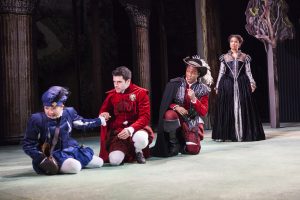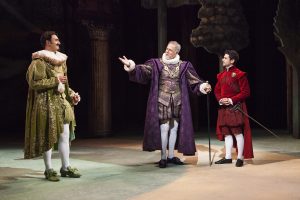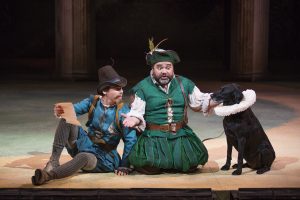‘Two Gents’ Trimmed and Polished for Old Globe
A tab version of Two Gents? Less than the two-traffic of our stage with no intermission?
Well, why not? Two Gentlemen of Verona is early Shakespeare, young Will with a learner’s permit, and it always gets trimmed anyway. A 1966 Globe production by Allen Fletcher even turned it into a musical comedy libretto. (An idea, I always like to point out, that was subsequently borrowed by another of that summer’s Globe guest directors, Mel Shapiro, for a very successful and lucrative Broadway version.)

Two Gentlemen of Verona on the stage of the Old Globe’s outdoor Lowell Davies Festival Theatre. Jim Cox Photos
For lack of any elaboration in the program credits, I’ll assume director Mark Lamos supervised the surgery and a dandy job he has done! I haven’t the energy, these warm August days, to pour over the text and find out what’s been dumped. It doesn’t matter anyway. The small but shapely core of the piece is all there. The other stuff can be seen as disposable Styrofoam (©?) packing.
The story needs to be seen through the prism of idealized Renaissance romanticism, so Lamos and his designer colleagues lean heavily on a polished vision from Italian oil paintings and dance music. The characters that count are all nobility or servants of same and the passions are as pure as spring water.

Kristin Villanueva, Adam Kantor, Hubert Point-Du Jour and Britney Coleman, left to right, in Old Globe Two Gentlemen of Verona.
What makes Two Gents so dear is that these stereotypes are bursting their bonds, like fruit ripening faster than expected. The two pals of the title spend long moments bragging of their manly devotion and loyalty to each other but events move in different directions. Their ladyloves play the simpering princess games with virtuosity but, when necessary, they’ll stride off into the woods like rangers.
The various silly supporting rolls get a bit confusing as to what’s really up and, again, blame Shakespeare, not Lamos. These parts rely on the staples of the comedian’s trade and besides, there’s this dog.
Famously, actors don’t want to play scenes with animals or children, but Crab, the clown‘s dog in Two Gents, is something of an exception. The best Crabs more or less just sit there, serving as a prop for their master Launce and his friend Speed. So it is with “Khloe Jezbera,” the hound of the moment, who seems a bit too classy but does know how to pay attention.
Hubert Point-Du Jour plays Valentine, the taller, calmer and truer of the gents, and Adam Kantor is Proteus, the one you don’t want to trust. He splatters signs and vows and songs all over his Julia right up until the exact moment when he spots Sylvia. (Romeo is hot for Rosalind until he sees Juliet at the ball, but he takes a few long looks before shifting affection. Proteus’ first look at Sylvia is as if he’s run into a wall.)
As Julia, Kristin Villanueva is pug dog cute and adorably ardent. Britney Coleman is more regal and graceful as Sylvia, but neither of them would be clear favorites in top girl competition. So that leaves the eye of Proteus as the chief engine of the story.
To the annoyance of generations of romantics, Proteus sees the error of his ways, reforms and talks everybody into buying this just in time for the happy ending. It really is as if, so a Shakespeare mentor of mine used to theorize, the author looked at the clock and realized he had to wrap this thing up.
Kantor and Point-Du Jour manage a nice separation in their seemingly similar characters and their ladies are solid. But it’s the supporting cast that most delights me this time. Lamos has chosen actors who know how to be quick and effective and he’s given them the room. Thus, Rusty Ross sets up Speed right away as the hero’s wiseacre servant, always ready with a quip for a tip, and Richard Ruiz telegraphs with makeup and posture Launce the self-pitying loser who needs a dog, before he delivers his first line.

Lowell Byers, Mark Pinter and Adam Kantor, left to right, in Two Gentlemen of Verona at the Old Globe.
I also appreciated Erin Elizabeth Adams as Julia’s wise nurse, and Lowell Byers as Turio, the studly fool hopelessly chasing Sylvia, but I really enjoyed Mark Pinter in a couple of dignified character roles. Here’s an actor around which to build any supporting cast, handsome, elegant, well-spoken and endlessly creditable. (I notice, by the way, that Pinter played Horatio in Jack O’Brien’s 1977 Hamlet at the Globe. In the title role on that occasion was…Mark Lamos. Small world.)
John Arnone’s splendid scenery, as lit by Stephen Strawbridge, looks to me like a cross between Maxwell Parrish and the Japanese animated fantasies of Hayao Miyazaki, a fine pedigree. Linda Cho’s costumes excel in period accuracy but are surprisingly monochromatic. (Does everybody in Verona wear scarlet?) And one of the production’s chief triumphs is the recorded score – exhilarating bursts of baroque dazzle channeling Michael Praetorius– by Fitz Patton.
[box] Continues at 8 p.m. Tuesdays through Sundays in the Globe’s outdoor Lowell Davies Festival Theatre through Sept 2, 2014, and at 7 p.m. Tuesdays, Wednesdays and Sundays and 8 p.m. Thursdays-Saturdays thereafter through Sept. 14, 2014.[/box]

Welton Jones has been following entertainment and the arts around for years, writing about them. Thirty-five of those years were spent at the UNION-TRIBUNE, the last decade was with SANDIEGO.COM.



